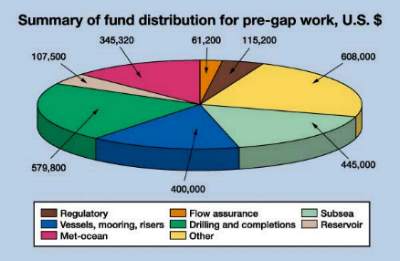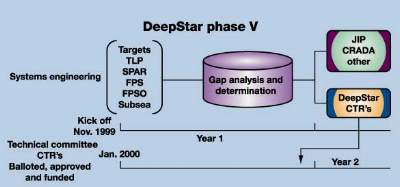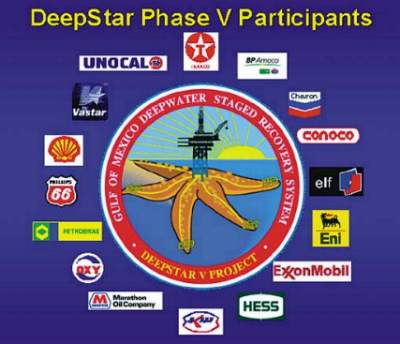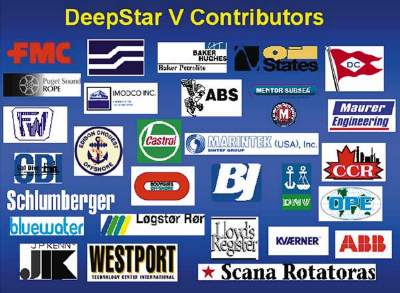|
May 2000
Vol. 221 No. 5
Feature Article
|
DeepStar enters fifth phase of deepwater mission
In its first eight years, this colossal industry
effort has accomplished much in the field of offshore R&D. Still more remains to be done,
and an ambitious agenda has been set for the program’s next two-year phase
Paul R. Hays, Texaco Inc. and G. Ray Seid, Paragon
Engineering Services, Inc., Houston
 eepStar
is an industry-led cooperative effort to develop economically viable, fit-for-purpose,
deepwater production technology that has global applicability. This program also supports
efforts to gain regulatory acceptance of any technology that is developed. eepStar
is an industry-led cooperative effort to develop economically viable, fit-for-purpose,
deepwater production technology that has global applicability. This program also supports
efforts to gain regulatory acceptance of any technology that is developed.
Although DeepStar’s focus has centered on the deepwater
Gulf of Mexico (GOM), much of the technology will have worldwide application. Organized in
1992 and managed by Texaco, DeepStar has sought to upgrade and advance deepwater subsea and
floating production systems technology. It also has brought together the industry’s
leading experts in a common, multidisciplinary forum to address technical issues confronting
economically viable deepwater output.
The program also has established a strong working
relationship with the U.S. Minerals Management Service (MMS) and the U.S. Coast Guard
(USCG), to assist in resolving regulatory issues that potentially could affect the risk and
safety aspects of design, implementation and operation of future deepwater production
systems.
DeepStar’s Goals
DeepStar’s vision for development of deepwater
technology is closely tied to the concept of cooperation, including evolution of a
synergistic relationship with all members of the oil community. In today’s competitive
environment, development of deepwater fields will be difficult, if not impossible, without
significant improvements in production technology.
DeepStar has several primary goals, one of which is to
improve the profitability, execution, operability and reliability of existing deepwater
production system technology. Another goal is to develop new technology to enable production
in areas that, in technical terms, are currently unproven. A specific target is to develop
the technology required for economic production in water depths as great as 10,000 ft.
Furthermore, DeepStar will work to ensure the acceptance of
such deepwater technology, including the development of industry standards and practices, as
appropriate. The program also will provide a forum for discussion, guidance and feedback
with contractors and vendors regarding deepwater production system technology capability
gaps, and to promote standardization of component interfaces. This new technology will most
likely not evolve outside a jointly funded, cooperative effort.
DeepStar’s Vision
The program has been very active over the past eight years.
DeepStar originally was envisioned as being a five-to-six-year program that would evolve and
demonstrate the technical feasibility of components associated with identified development
concepts. The evolution has been gradual, and progress has been steady.
DeepStar has fostered numerous technological successes over
its first eight years. These include:
- Testing and evaluation of polyester rope for use in Taut
Leg Mooring Systems, resulting in a proposed API standard
- Successful model testing of a system to prevent or
minimize leakage / spillage from deepwater pipelines during repair operations
- Initiation of governmental efforts to develop a generic
Environmental Impact Statement related to FPSOs operating in the GOM
- Advancement of fiber optics and sensor technology, to
detect and measure flowline conditions relating to paraffin and hydrate deposition
- Development and commercialization of an extended-reach,
coiled tubing system for wax remediation
- Development of guidelines for an industry-supported
Deepwater Pipeline Alliance that will provide the required pipeline repair equipment
- Identification of new chemical inhibitors for paraffin
remediation
- Successful and safe demonstration of hydrate blockage
removal in flowlines by lowering pressure in one side of the line
- Offshore deployment and successful testing of an
electrically heated pipe system.
The goal remains to provide technology, so that new systems
can be implemented with a relatively high degree of confidence. Timing and scope of various
DeepStar phases have been expanded and structured to progress from initial feasibility
evaluations to detailed technical studies and, on occasion, hardware / systems development.
With the January 2000 "kick-off" of the program’s
newest two-year period – the Phase V projects – further evolution of the program
depends on participants’ technology interests and the real or perceived need to
establish prototype hardware with associated qualification programs. A deepwater component
and/or field demonstration project also may be necessary to establish sufficient industry
confidence in the commercial viability of a concept and its associated technology. However,
at this point, DeepStar is pausing to undertake a systematic assessment of technological
gaps that need to be filled, so that the industry can produce from water depths out to
10,000 feet.
| |
Summary of Phase V’s approved
work |
|
|
- Chilled, multiphase, single, bare flowlines
- Flow assurance operational practices manual for
deep water
- Minimum facilities buoy for remote control of
subsea production in deep water
- Pipe-in-pipe external pressure and bending collapse
- SCR fatigue damage monitoring and inspection
- Pipeline blockage remediation strategies for
long-offset, subsea flowlines and pipelines
- Subsea processing feasibility study
- Coupled analysis / theme structures
- Improve pore pressure prediction ahead of the bit
- Update shallow water-flow database
- Formation compressibility
- Six-month turnaround cruise / Yucatan inflow
measurement
- Execution of system engineering
|
|
|
|
|
When DeepStar began in 1992, phased subsea production
systems, operating as extensions of shallow-water platforms, were identified as an essential
mechanism for commercial development of deepwater prospects. Although long-offset, subsea
tie-back production systems may provide commercially attractive solutions for many deepwater
fields, alternative floating production systems are now incorporated into DeepStar’s
technology program, to offer other potential development scenarios. Today’s deepwater
development solutions still appear to give preference to surface-based completions, as
evidenced by the number of developments utilizing TLPs, spars and compliant towers since
1992.
Even though the price of oil now appears high, incremental
production / development remains vital for controlling risk and minimizing capital exposure.
Examples of ideas to be pursued include: 1) Completing and producing field delineation
wells, rather than abandoning them following exploration; 2) Designing modular equipment for
the initial production program that can be integrated into any subsequent field development;
and 3) Using the production experience from initial wells to improve on subsequent,
full-field development optimization. Such elements are supportive of strategies to give
world-class economic returns to deepwater opportunities.
At Shell’s Mensa subsea tie-back, GOM production is now
occurring in water depths greater than 5,000 ft. The industry is very interested in flow
assurance issues, and methods to reduce cost and improve equipment reliability. Field
qualification of the emerging technologies could become a significant part of DeepStar’s
future work following the Systems Engineering Committee’s gap analysis effort. In
DeepStar Phase IV, water depth range was extended to 10,000 ft from 6,000 ft, with a thrust
placed on high-impact, near-term applications with clear deliverables – preferably
field qualification of equipment or collection of field-quality data. The focus is on
applied work rather than fundamental or basic research.
Phase V Program Goals
The Phase V approach to achieving DeepStar’s goals will
be to address five topics. First of these is to perform a full-system analysis on a range of
deepwater production systems to identify issues associated with developing technically
feasible production systems in 10,000 ft of water ("enabling technology"), and
with improving existing production system technology ("enhancing technology").
A second item is to consolidate results of the full-system
analyses, to identify key enabling and enhancing technology issues that need to be addressed
to achieve the overall goals. Issues unique to certain concepts will be identified, as will
issues that pertain to a range of concepts. Issues will be high-graded to ensure that the
most important are addressed first. Priority will be placed on true feasibility issues. It
is anticipated that many issues will pertain to a specific technical area or subsystem and
will not necessarily be concept-specific.
The third topic is to identify potential means of addressing
these issues, which may include DeepStar-funded studies; separate, spin-off, joint industry
projects (JIPs); other ongoing JIPs or deferral. Fourth among Phase V tasks is to work with
the technical committees to develop projects that address key issues that should be handled
within DeepStar. The fifth and last goal is to implement projects with the highest potential
value to participants.
The technical committees already have developed several
projects for Phase V that have been approved by DeepStar’s Management Committee for
execution prior to completion of the full systems analysis. These were projects that were
well-aligned with the Phase V goals, addressed known technology gaps / opportunities and
provided clearly understood, tangible value. A breakdown of the budget for the Pre-Gap
Analysis technical work is provided in Fig. 1.
 |
|
Fig. 1. Several projects
that are well-aligned with Phase V goals, and address known technology gaps,
have been approved and budgeted prior to completion of the full systems
analysis. The projects cover a wide range of issues. |
|
Early Technology Program
Critical technical areas of common interest identified in
earlier DeepStar work were initiated in January 2000. Following the Management Committee’s
final ballot, the program’s early makeup is shown in the accompanying table. The key
technology areas, along with regulatory considerations, have been categorized into various
DeepStar V groups, discussion of which follows.
Regulatory issues. This committee acts as the
liaison group between the other DeepStar technical committees and the regulators, such as
the MMS and the USCG. The committee’s objective centers on the exchange of technical
information between DeepStar’s working technical groups and regulatory representatives
of the MMS and USCG. The MMS has participated actively in the Phase IV Regulatory Committee,
to become more aware of key technology issues that pose barriers to deepwater development or
require greater definition to avoid confusion over interpretation. The Regulatory Committee
also works and communicates with leading industry organizations, such as OOC, API and
others. The objective of this interface between DeepStar and other parties is expedient full
review of the relevant issues involved in deployment of new tools or processes while
developing GOM fields.
Flow assurance. This committee has been one of the
most aggressive panels with respect to achieving coherent understanding of state-of-the-art
flow assurance technology. Committee members have worked hard to define both near- and
long-term goals to advance knowledge of flow assurance. The "stretch" goal of the
Flow Assurance Committee is to ensure reliable, economic deepwater production by appropriate
design and operation through: 1) Prediction; 2) Management; and 3) Remediation of deposition
and line plugs.
Controls, pipelines and subsea equipment. The Subsea
Committee’s goal is to develop technology and qualify equipment, to enable deployment
of "subsea facilities for 60-mile tie-back from 10,000-ft water depth." The
minimum-facilities buoy is being explored as an economic alternative to an electrohydraulic
umbilical-based system. The pipe-in-pipe external pressure and bending collapse study should
lead to modification of the API-RP for collapse.
Another effort will develop guidelines and a strategy for
remediating different types of blockages in long-offset subsea flowlines and pipelines.
Another technical project will assess state-of-the-art, subsea processing systems and the
overall feasibility of using them to enhance output performance in deepwater oil production
applications.
Vessels, mooring and risers. This committee’s
role is to further technology and fill gaps for deepwater floating systems, and their
associated moorings and risers. Most prominent over the last several years has been the
advancement of polyester mooring technology. DeepStar will continue work to gain regulatory
acceptance of these moorings in the GOM.
During Phase IV, the committee began an effort to advance
industry’s understanding of floating systems’ analytic capabilities. During Phase
V, model tests will be used to verify analysis capabilities for a variety of deepwater
production concepts ("theme structures"), and their associated moorings and
risers. In addition, model tests will be used to augment industry’s knowledge of
vortex-induced vibrations on deepwater riser systems.
Drilling and completion. Committee members are
sharing experience and data to improve deepwater GOM drilling operations. The Drilling
Committee is now pursuing other technologies actively, including prediction of pore pressure
ahead of the bit, in addition to updating a database on shallow-water flow phenomena.
Reservoir engineering. This committee looks at
trends that are of significant generic interest to the industry, while avoiding detailed
reservoir issues where participants have competitive concerns. Early in Phase V, the
Reservoir Committee will summarize and identify the pros and cons of procedures used to
measure formation compressibility and pressure-dependent permeability.
Met-Ocean. This committee is conducting a program
that will compile the first comprehensive measurements of current inflow into the GOM. This
project’s ultimate goal is to improve knowledge and modeling capabilities of GOM
circulation, which will provide more accurate design criteria and reduce downtime during
deepwater drilling. Phase V efforts extend Phase IV’s current data acquisition work and
allow for early data retrieval, as well as collection of a second data set.
Systems Engineering Committee Efforts
The "Systems Engineering" Committee takes on the
responsibility of ensuring that these steps to achieve DeepStar’s goals are taken in a
timely and efficient manner, and for communicating progress and results to an oversight
panel. This committee is therefore charged with developing criteria needed for the 10,000-ft
study (e.g., reservoir characteristics, met-ocean criteria, etc.) and ensuring consistency
between the various contractor studies. In particular, the Systems Engineering Committee is
responsible for ensuring that the framework steps outlined above are accomplished.
The outcome of the full systems analysis will be an
identification of "gaps" and "opportunities" for a range of production
systems in water depths to 10,000 ft. The alternatives considered are shown in Fig. 2. This
figure also broadly illustrates the time-line.
 |
|
Fig. 2. In conjunction with
the time-line shown, the full systems analysis will identify "gaps"
and "opportunities" for a range of production systems in water depths
to 10,000 ft. |
|
The first step in this process was to develop a detailed
work scope for the analysis, including specific goals, and the process to best achieve them.
The Systems Engineering Committee began with a full-system analysis of extended reach
tie-backs first, to ensure the process is well-suited to achieving the goals of this effort.
The first effort’s lessons will be incorporated into the subsequent four analyses. The
path chosen was to build on the work already done to develop subsea systems in 10,000 ft of
water; identifying additional work that is needed to perform a "full-system"
analysis; and then developing work scopes for the subsequent system analyses to be performed
on the remaining four concepts.
Post-Systems Analysis
After the full-system analyses are completed, the Systems
Engineering group in Phase V will consolidate results of the analyses, including a
first-pass grouping and prioritization of issues. Issues will be grouped as "enabling"
or "enhancing" and as "concept-specific" or "multi-concept."
For example, TLP tendons in 10,000 ft would be an enabling, concept-specific technical
issue, while top-tensioned riser design in 10,000 ft would be an enabling, multi-concept
issue. A plan to address the issues identified in the full system analyses will be
developed, and will include the following options:
- Address within DeepStar
- Address as a separate spin-off JIP
- Being addressed through a separate ongoing or proposed
JIP
- Do not address at the present time.
Criteria used to determine whether to address an issue
within DeepStar will include relative criticality of the issue (e.g., how big is the gap?),
cost and duration needed to adequately address the issue, and whether the issue is already
being addressed through separate JIPs.
The results of this evaluation would be reviewed with the
Management Committee. Once final endorsements are achieved, the technical committees would
be charged with developing technical projects to focus on issues the Management Committee
has determined should be addressed within DeepStar. In some cases, a technical committee may
have work scopes already prepared prior to Phase V, to address one or more of the issues
considered critical.
An objective of the enabling technology development effort
is to devise technically feasible configurations for three production systems in 10,000 ft
of water – one surface tree concept, one subsea tree concept and an all-subsea
approach. If a contractor identifies an alternative concept that the Management Committee
feels offers incentives compared to the original five concepts, then this new concept will
be considered for evaluation as part of Phase V.
Wrap-Up
DeepStar Phase V has kicked off with 16 participating oil
companies (Fig. 3) and 31 vendor / service companies (Fig. 4) with a $8-million budget –
not an inconsequential undertaking! The systems engineering effort was endorsed unanimously
by the participants, and it provides the fertile ground for a very active program.
 |
|
Fig. 3. DeepStar Phase V
has gained the participation of 16 oil companies. |
|
 |
|
Fig. 4. So far, 31
equipment / service companies are cooperating in DeepStar Phase V. |
|
On March 16, 2000, an effort was launched to obtain closer
ties with the vendor community in a technology gap workshop focused on subsea,
extended-reach tie-backs. DeepStar will continue to grow these relationships as it hosts
workshops to focus on technology gaps for other systems needed to advance out to the
10,000-ft water depth. DeepStar Phase V is DeepStar renewed.


The authors
 Paul
R. Hays, DeepStar Project Manager, Texaco Inc.,
Houston, received a PhD degree in theoretical and applied mechanics from the University of
Illinois in Urbana in 1980. He worked for a year on flutter analysis for the aerospace
industry before joining the oil industry in 1981. His early involvement with deep water was
with field development technology for 1,000-ft water offshore Norway, with initial technical
focus on deepwater production / drilling. DeepStar was a $5-million program when he assumed
leadership in February 1998. He has nurtured its growth into the Phase V program ongoing
today. Paul
R. Hays, DeepStar Project Manager, Texaco Inc.,
Houston, received a PhD degree in theoretical and applied mechanics from the University of
Illinois in Urbana in 1980. He worked for a year on flutter analysis for the aerospace
industry before joining the oil industry in 1981. His early involvement with deep water was
with field development technology for 1,000-ft water offshore Norway, with initial technical
focus on deepwater production / drilling. DeepStar was a $5-million program when he assumed
leadership in February 1998. He has nurtured its growth into the Phase V program ongoing
today.
 G.
Ray Seid is employed by Paragon Engineering
Services Inc. and has been seconded to the DeepStar program for the past two years. Mr. Seid’s
career spans 35 years in the industry, the greater portion of which has been related to the
development of subsea oil and gas production systems. He holds a BS degree from Penn State
University (1954). G.
Ray Seid is employed by Paragon Engineering
Services Inc. and has been seconded to the DeepStar program for the past two years. Mr. Seid’s
career spans 35 years in the industry, the greater portion of which has been related to the
development of subsea oil and gas production systems. He holds a BS degree from Penn State
University (1954).
|





 Paul
R. Hays, DeepStar Project Manager, Texaco Inc.,
Houston, received a PhD degree in theoretical and applied mechanics from the University of
Illinois in Urbana in 1980. He worked for a year on flutter analysis for the aerospace
industry before joining the oil industry in 1981. His early involvement with deep water was
with field development technology for 1,000-ft water offshore Norway, with initial technical
focus on deepwater production / drilling. DeepStar was a $5-million program when he assumed
leadership in February 1998. He has nurtured its growth into the Phase V program ongoing
today.
Paul
R. Hays, DeepStar Project Manager, Texaco Inc.,
Houston, received a PhD degree in theoretical and applied mechanics from the University of
Illinois in Urbana in 1980. He worked for a year on flutter analysis for the aerospace
industry before joining the oil industry in 1981. His early involvement with deep water was
with field development technology for 1,000-ft water offshore Norway, with initial technical
focus on deepwater production / drilling. DeepStar was a $5-million program when he assumed
leadership in February 1998. He has nurtured its growth into the Phase V program ongoing
today. G.
Ray Seid is employed by Paragon Engineering
Services Inc. and has been seconded to the DeepStar program for the past two years. Mr. Seid’s
career spans 35 years in the industry, the greater portion of which has been related to the
development of subsea oil and gas production systems. He holds a BS degree from Penn State
University (1954).
G.
Ray Seid is employed by Paragon Engineering
Services Inc. and has been seconded to the DeepStar program for the past two years. Mr. Seid’s
career spans 35 years in the industry, the greater portion of which has been related to the
development of subsea oil and gas production systems. He holds a BS degree from Penn State
University (1954).
